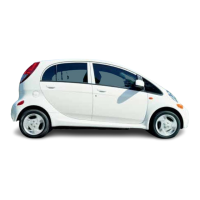2D-30 Chapter 2 Part D General engine overhaul procedures
24.13 Lay the Plastigage strips on each
rod bearing journal, parallel to the
crankshaft centerline
BEARING BLOCK
TAB NOTCHES
24.14 Match up the cylinder number
marks and the bearing tab notches when
installing the connecting rod caps
connecting rod journal, parallel with the journal axis
(see illustration).
14 Clean the connecting rod cap bearing face, remove the protective
hoses from the connecting rod bolts and install the rod cap. Make sure the
mating mark on the cap is on the same side as the mark on the connecting
rod
(see illustration).
15 Install the nuts and tighten them to the torque listed in this Chapter’s
Specifications.
Work
up to it in three steps.
Note: Usea thin-wallsocket to
avoid erroneous forque readings that can result if the socket is wedged
between the rod cap and nut. If the socket rends to wedge itself between
rhenutand rhecap, /iftuponits/ight/yunri/irno/ongercontacts rhecap.
Do
not rotate the crankshaft at any time during this operation.
16 Removethe nutsanddetach the rodcap, beingverycareful nottodis-
turb the Plastigage.
17 Compare the width of the crushed Plastigage to the scale printed on
the Plastigage envelope to obtain the oil clearance
(see illustration).
Compare it to this Chapter’s Specifications to make sure the clearance is
correct.
18 If the clearance is not as specified, the bearing inserts may be the
wrong size (which means different ones will be required). Before deciding
differentinsertsareneeded, makesurenodirtoroilwas between the bear-
ing inserts and the connecting rod or cap when the clearance was mea-
sured. Also, recheck the journal diameter. If the Plastigage was wider at
one end than the other, the journal may be tapered (see Section 18).
Final connecting rod installation
19 Carefully scrape all traces of the Plastigage material off the rod jour-
nal and/or bearing face. Be very careful not to scratch the bearing - use
your fingernail or the edge of a credit card.
20 Make sure the bearing faces are perfectly clean, then apply a uniform
layer of clean moly-base grease or engine assembly lube to both of them.
You’ll have to push the piston into the cylinder to expose the face of the
bearing inserttn the connecting rod - be sure to slip the protective hoses
over the rod bolts first.
21 Slide the connecting rod back into place on the journal, remove the
protective hoses from the rod cap bolts, install the rod cap and tighten the
nuts to the torque specified in this Chapter. Again, work up to the torque in
three steps.
Note: Again, make sure the mating mark on the cap is on the
same side as the mark on the connecting rod (see illustration 24.14).
22 Repeat the entire procedure for the remaining pistons/connecting
rods.
23 The important points to remember are . . .
a) Keep the back sides of the bearing inserts and the insides of the
connecting rods and caps perfectly clean when assembling them.
b) Make sure you have the correct piston/rod assembly for each cylin-
der.
c) The arrow or mark on the piston must face the front (timing chain
end) of the engine.
24.17 Measuring the width of the
crushed Plastigage to determine the rod
bearing oil clearance (be sure to use the
correct scale - standard and metric ones
are included)
d) Lubricate the cylinder walls with clean oil.
e) Lubricate the bearing faces when installing the rod caps after the
oil clearance has been checked.
24 After all the piston/connecting rod assemblies have been properly in-
stalled, rotate the crankshaft a number of times by hand to check for any
obvious binding.
25 As a final step, the connecting rod endplay must be checked. Refer to
Section 12 for this procedure.
26 Compare the measured endplay to this Chapter’s Specifications to
make sure it’s correct. If it was correct before disassembly and the original
crankshaft and rods were reinstalled, it should still be right. If new rods or
a
new crankshaft were installed, the endplay may be inadequate. If so, the
rods will have to be removed and taken to an automotive machine shop for
restzing.
25 Initial start-up and break-in after overhaul .
Warning: Have a fire exringuisher handy when starting the engine for the
first time.
1 Once the engine has been installed in the vehicle, double-check the
engine oil and coolant levels.
2 With the spark plugs out of the engine and the ignition system dis-
abled (see Section 31, crank the engine until oil pressure registers on the
gauge or the light goes out.
3 Install the spark plugs, hook up the plug wires and restore the ignition
system functions (see Section 3).
4 Start the engine. It may take a few moments for the fuel system to
build up pressure, but the engine should start without a great deal of effort.
Note: If backfiring occurs through rhe carburetor or throttle body, recheck
the valve timing and ignition timing.
5 After the engine starts, it should be allowed to warm up to normal op-
erating temperature. While the engine is warming up, make
a
thorough
check for fuel, oil and coolant leaks.
6 Shut the engine off and recheck the engine oil and coolant levels.
7 Drive the vehicle to an area with minimum traffic, accelerate at full
throttle from 30 to 50 mph, then allow the vehicle to slow to 30 mph with the
throttle closed. Repeat the procedure IO or 12 times. This will load the pis-
ton rings and cause them to seat properly against the cylinder walls.
Check again for oil and coolant leaks.
8 Drive the vehicle gently for the first 500 miles (no sustained high
speeds) and keep a constant check on the oil level. It isn’t unusual for an
engine to use oil during the break-in period.
9 At approximately 500 to 600 miles, change the oil and filter.
10 For the next few hundred miles, drive the vehicle normally. Don’t pam-
per it or abuse it.
11 After 2000 miles, change the oil and filter again and consider the en-
gine broken in.

